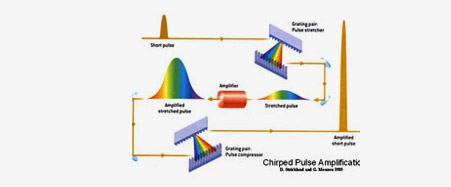Articles
How do we get to high laser intensities ?
How do we get to high laser intensities ?
In CPA, the ultrashort pulse is not amplified directly, but is first stretched and then amplified, before finally being recompressed. CPA reconciles two apparently conflicting needs: to have the highest fluence for efficient energy extraction, and to have minimum intensity to avoid the undesired nonlinear effects.

CPA involves impressive manipulations: stretching by 105, amplification by 1011 (from nano-joules to tens of joules) and recompression by 105. Because we want the highest intensities on target, it is important that these manipulations be performed with the highest degree of fidelity, so that the pulse possesses the highest temporal contrast and the beam is diffraction limited. To reach this goal, two main hurdles had to be overcome: the accommodation of the large stretching/compression ratio, and the amplification of large pulse spectra.
It is possible to stretch and compress a short pulse over many orders of magnitude with impunity and fidelity with a matched stretcher and compressor. The first CPA system used the positive group velocity dispersion (in which the red wave-length goes faster than the blue) of a single-mode fiber to temporally spread the frequency components of the ultrashort pulses. After passing through the fiber, the pulse is stretched with the red component first, followed by the blue. It is then amplified to the desired level and recompressed by a pair of parallel diffraction gratings. As demonstrated by Brian Treacy of United Aircraft Research Laboratories, a grating pair exhibits a negative group velocity dispersion (blue goes faster than red However, the fiber stretcher and diffraction grating compressor did not have their dispersive characteristics exactly matched, so the recompression was not perfect, leading to temporal wings in the pulse, and hence limiting the stretching/compression ratio to about 100. A "compressor" designed by Oscar Martinez at the University of Buenos Aires for optical communication, to compress pulses at a 1500 nm wavelength based on a dispersive system with a telescope of magnification 1 placed between two antiparallel gratings had the exact same dispersive function as the Treacy compressor, but with the opposite sign. In other words, it was the Treacy compressor's perfect conjugate—with the important consequence that any arbitrary short pulse in theory could be stretched to any pulse duration and then recompressed to its original shape.
CPA had a dramatic impact in short-pulse amplification. First, one could for the first time use superior (by a factor of 1000) energy storage media such as neodymium:glass, alexandrite, titanium:sapphire and chro-mium:LiSrAlFg instead of dye and excimer. So a CPA laser system, using these good energy storage media, could produce peak power lO'^lO4 times higher than could dye or excimer systems of equivalent size. Second, CPA could be easily adapted for use with very large scale, expensive lasers already built for laser fusion. By simple beam manipulations, a stretching at the beginning and a com- pression at the end of the amplifying chain, laser fusion systems built to amplify nanosecond pulses to the terawatt level could be converted to amplify subpicosecond pulses to produce petawatt pulses.
Further reading
- M.D. Perry and G. Mourou, Science 264, 917 (1994).
- G. Mourou, C.P.J. Barty and M.D. Perry, Physics Today, p22 1998.



